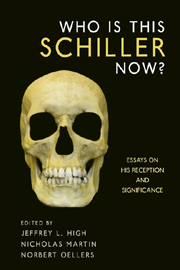Book contents
- Frontmatter
- Contents
- Foreword
- Acknowledgments
- List of Abbreviations
- Introduction: Why Is This Schiller [Still] in the United States?
- Part I Schiller, Drama, and Poetry
- Part II Schiller, Aesthetics, and Philosophy
- Part III Schiller, History, and Politics
- Part IV Schiller Reception — Reception and Schiller
- 17 Schiller and the Gothic — Reception and Reality
- 18 Schiller's Plays on the British Stage, 1797–1825
- 19 From Martyr to Vampire: The Figure of Mary Stuart in Drama from Vondel to Swinburne
- 20 A Chapter of Schiller in America: The First World War and Volume 3 of Kuno Francke's Edition of The German Classics
- 21 The Reluctant Recruit? Schiller in the Trenches, 1914–1918
- 22 Schiller — Kommerell — George. Eine Konstellation der Moderne
- 23 Was sagte dieser Schiller (damals)? Schillers Antworten auf seine Kritiker nach 1945
- Part V Schiller Now
- Notes on the Contributors
- Index
23 - Was sagte dieser Schiller (damals)? Schillers Antworten auf seine Kritiker nach 1945
from Part IV - Schiller Reception — Reception and Schiller
Published online by Cambridge University Press: 05 February 2013
- Frontmatter
- Contents
- Foreword
- Acknowledgments
- List of Abbreviations
- Introduction: Why Is This Schiller [Still] in the United States?
- Part I Schiller, Drama, and Poetry
- Part II Schiller, Aesthetics, and Philosophy
- Part III Schiller, History, and Politics
- Part IV Schiller Reception — Reception and Schiller
- 17 Schiller and the Gothic — Reception and Reality
- 18 Schiller's Plays on the British Stage, 1797–1825
- 19 From Martyr to Vampire: The Figure of Mary Stuart in Drama from Vondel to Swinburne
- 20 A Chapter of Schiller in America: The First World War and Volume 3 of Kuno Francke's Edition of The German Classics
- 21 The Reluctant Recruit? Schiller in the Trenches, 1914–1918
- 22 Schiller — Kommerell — George. Eine Konstellation der Moderne
- 23 Was sagte dieser Schiller (damals)? Schillers Antworten auf seine Kritiker nach 1945
- Part V Schiller Now
- Notes on the Contributors
- Index
Summary
Friedrich Schiller — uncritical late Enlightenment philosopher, blind idealist, and dangerously abstract aesthetic thinker? This stereotypically negative classification of the “classical” Schiller was established in the second half of the twentieth century by Theodor W. Adorno, Max Horkheimer, Paul de Man, and Terry Eagleton. Schiller clearly defines aesthetic education as a path from barbarism, which he sees as a dangerous product of an incomplete enlightenment, as expressed in his Philosophische Briefe (Philosophical Letters, 1786) and in his essay Ueber naive und sentimentalische Dichtung (On the Naive and Sentimental in Literature, 1795–96; 1800). Schiller's post-1945 critics, on the other hand, argue that the fascist barbarism of the twentieth century was conditioned through Enlightenment, idealism, and aestheticization. The connection between Schiller's aesthetic education and twentieth-century German fascism is a highly questionable construct at the very best, as is evident in the comparison of Schiller's remarkably articulate condemnation of the dangers of a partial aesthetic education. Schiller not only addressed his twentieth-century critics; he specifically criticized the political misuse of aesthetics that would inform their responses.
FRIEDRICH SCHILLER — unkritischer Spätaufklärer, blinder Idealist und gefährlicher Ästhetiker. Theodor W. Adorno, Max Horkheimer, Paul de Man und Terry Eagleton ankern ihre Kritik am Klassiker1 Schiller in der zweiten Hälfte des 20. Jahrhunderts an diese stereotype Negativetikettierung. Adornos und Horkeimers Vorwürfe können allgemein aus ihrem Verständnis der Aufklärung selbst abgeleitet werden, wie es in Dialektik der Aufklärung (1947) beschrieben wird. So beginnt das erste Kapitel wie folgt: “Seit je hat Aufklärung im umfassendsten Sinn fortschreitenden Denkens das Ziel verfolgt, von den Menschen die Furcht zu nehmen und sie als Herren einzusetzen.
- Type
- Chapter
- Information
- Who Is This Schiller Now?Essays on his Reception and Significance, pp. 383 - 400Publisher: Boydell & BrewerPrint publication year: 2011



